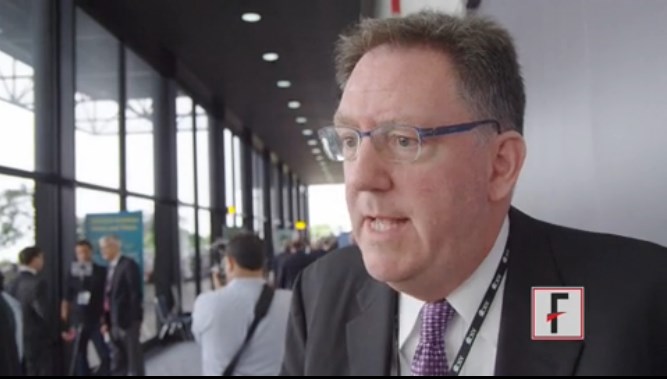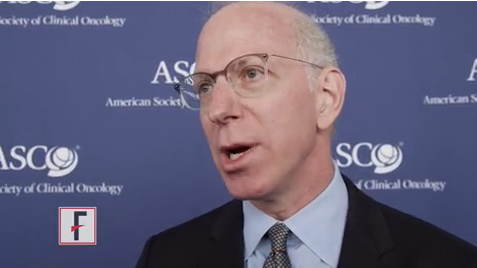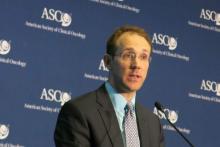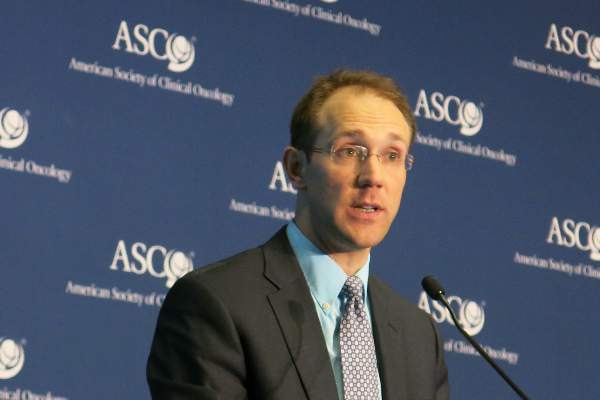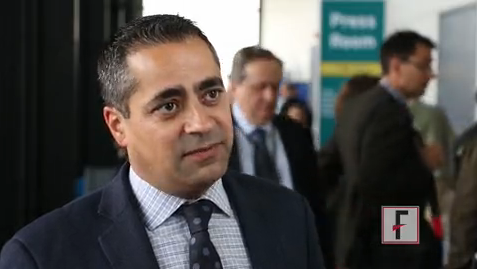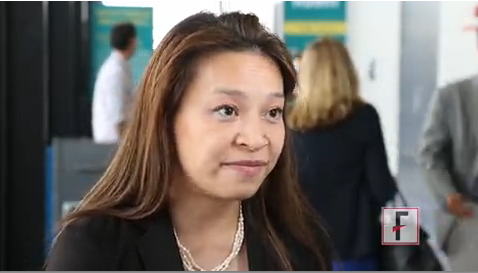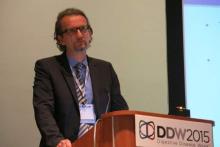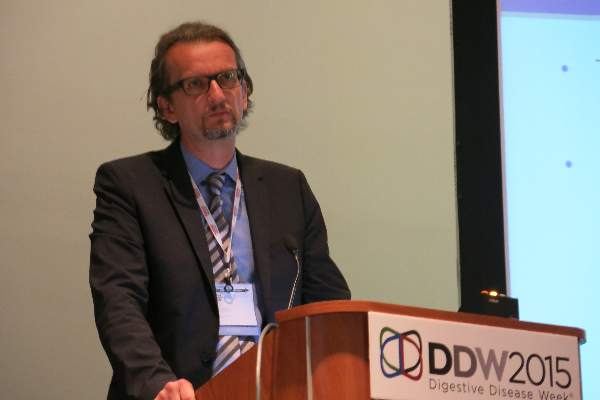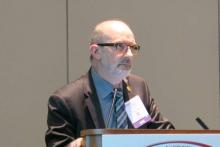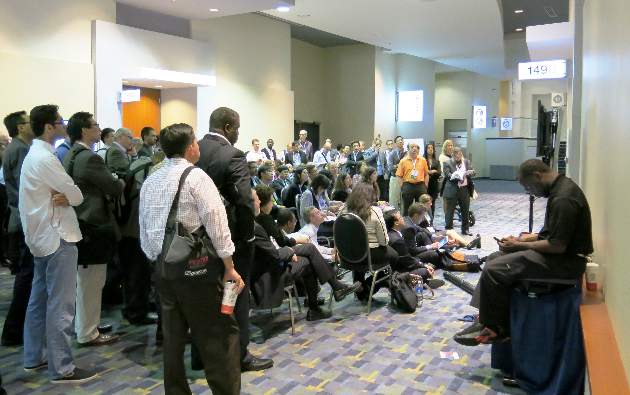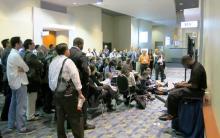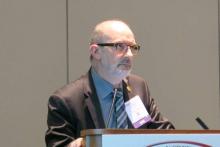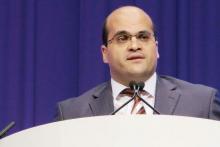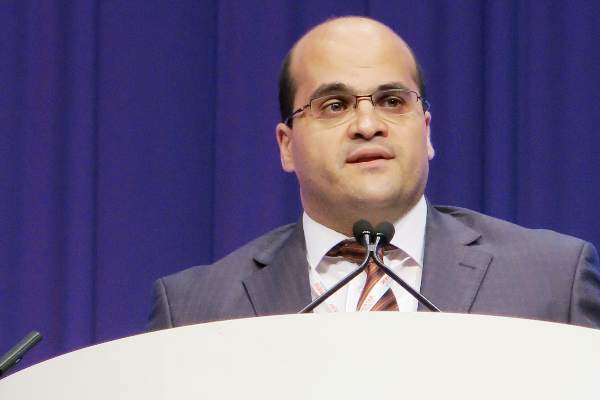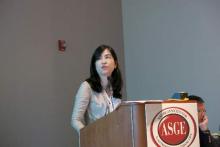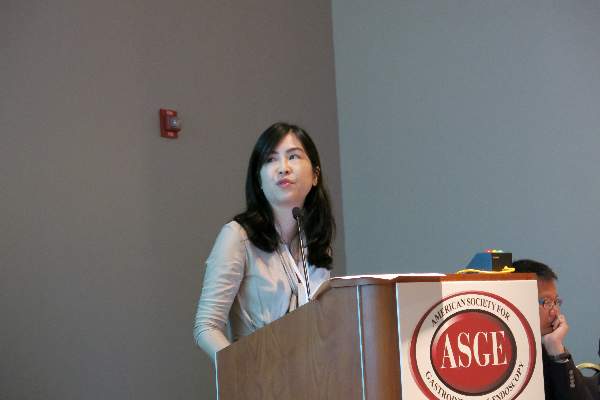User login
VIDEO: Dual immunotherapy more powerful in melanoma, but where do we go from here?
CHICAGO – Combining the immunotherapy antibodies nivolumab and ipilimumab induced more robust responses in untreated advanced melanoma when used together than as single agents, according to phase III results reported at the annual meeting of the American Society of Clinical Oncology.
In an interview at the meeting, Dr. Steven O’Day, whose ipilimumab research rocked ASCO audiences just 5 years ago, gives his insights into the results, what they mean for the future of ipilimumab, and what clinicians may possibly see at ASCO 2016.
The study was sponsored by Bristol-Myers Squibb. The lead investigator, Dr. Jedd D. Wolchok, reported financial relationships with BMS and several other firms.
The video associated with this article is no longer available on this site. Please view all of our videos on the MDedge YouTube channel
On Twitter @pwendl
CHICAGO – Combining the immunotherapy antibodies nivolumab and ipilimumab induced more robust responses in untreated advanced melanoma when used together than as single agents, according to phase III results reported at the annual meeting of the American Society of Clinical Oncology.
In an interview at the meeting, Dr. Steven O’Day, whose ipilimumab research rocked ASCO audiences just 5 years ago, gives his insights into the results, what they mean for the future of ipilimumab, and what clinicians may possibly see at ASCO 2016.
The study was sponsored by Bristol-Myers Squibb. The lead investigator, Dr. Jedd D. Wolchok, reported financial relationships with BMS and several other firms.
The video associated with this article is no longer available on this site. Please view all of our videos on the MDedge YouTube channel
On Twitter @pwendl
CHICAGO – Combining the immunotherapy antibodies nivolumab and ipilimumab induced more robust responses in untreated advanced melanoma when used together than as single agents, according to phase III results reported at the annual meeting of the American Society of Clinical Oncology.
In an interview at the meeting, Dr. Steven O’Day, whose ipilimumab research rocked ASCO audiences just 5 years ago, gives his insights into the results, what they mean for the future of ipilimumab, and what clinicians may possibly see at ASCO 2016.
The study was sponsored by Bristol-Myers Squibb. The lead investigator, Dr. Jedd D. Wolchok, reported financial relationships with BMS and several other firms.
The video associated with this article is no longer available on this site. Please view all of our videos on the MDedge YouTube channel
On Twitter @pwendl
AT THE ASCO ANNUAL MEETING 2015
VIDEO: More aggressive treatment with docetaxel boosts survival in prostate cancer
CHICAGO – Adding docetaxel chemotherapy to standard management improved survival in men with high-risk, localized, hormone-sensitive prostate cancer, results from the phase III RTOG 0521 study show.
At 4 years, overall survival was 89% without docetaxel and 93% with the addition of docetaxel (Toxotere) and prednisone after completing radiotherapy and long-term hormonal suppression (Hazard ratio, 0.70; P = .04).
“For the first time, improvement in overall survival was observed with adjuvant chemotherapy for localized, high-risk, hormone-sensitive prostate cancer,” Dr. Howard Sandler said in a press conference in advance of the formal presentation of the late-breaking study at the annual meeting of the American Society of Clinical Oncology.
The implications of the study are clinically relevant and wide-ranging, particularly in patients with high-risk disease, press briefing moderator Dr. Don Dizon, commented.
Dr. Sandler, chair of radiation oncology at Cedars-Sinai Medical Center, Los Angeles, gives details of this practice-changing study in a video interview.
The study was funded by the National Institutes of Health. Dr. Sandler reported financial relationships with several firms including Sanofi Aventis, maker of docetaxel.
The video associated with this article is no longer available on this site. Please view all of our videos on the MDedge YouTube channel
On Twitter @pwendl
CHICAGO – Adding docetaxel chemotherapy to standard management improved survival in men with high-risk, localized, hormone-sensitive prostate cancer, results from the phase III RTOG 0521 study show.
At 4 years, overall survival was 89% without docetaxel and 93% with the addition of docetaxel (Toxotere) and prednisone after completing radiotherapy and long-term hormonal suppression (Hazard ratio, 0.70; P = .04).
“For the first time, improvement in overall survival was observed with adjuvant chemotherapy for localized, high-risk, hormone-sensitive prostate cancer,” Dr. Howard Sandler said in a press conference in advance of the formal presentation of the late-breaking study at the annual meeting of the American Society of Clinical Oncology.
The implications of the study are clinically relevant and wide-ranging, particularly in patients with high-risk disease, press briefing moderator Dr. Don Dizon, commented.
Dr. Sandler, chair of radiation oncology at Cedars-Sinai Medical Center, Los Angeles, gives details of this practice-changing study in a video interview.
The study was funded by the National Institutes of Health. Dr. Sandler reported financial relationships with several firms including Sanofi Aventis, maker of docetaxel.
The video associated with this article is no longer available on this site. Please view all of our videos on the MDedge YouTube channel
On Twitter @pwendl
CHICAGO – Adding docetaxel chemotherapy to standard management improved survival in men with high-risk, localized, hormone-sensitive prostate cancer, results from the phase III RTOG 0521 study show.
At 4 years, overall survival was 89% without docetaxel and 93% with the addition of docetaxel (Toxotere) and prednisone after completing radiotherapy and long-term hormonal suppression (Hazard ratio, 0.70; P = .04).
“For the first time, improvement in overall survival was observed with adjuvant chemotherapy for localized, high-risk, hormone-sensitive prostate cancer,” Dr. Howard Sandler said in a press conference in advance of the formal presentation of the late-breaking study at the annual meeting of the American Society of Clinical Oncology.
The implications of the study are clinically relevant and wide-ranging, particularly in patients with high-risk disease, press briefing moderator Dr. Don Dizon, commented.
Dr. Sandler, chair of radiation oncology at Cedars-Sinai Medical Center, Los Angeles, gives details of this practice-changing study in a video interview.
The study was funded by the National Institutes of Health. Dr. Sandler reported financial relationships with several firms including Sanofi Aventis, maker of docetaxel.
The video associated with this article is no longer available on this site. Please view all of our videos on the MDedge YouTube channel
On Twitter @pwendl
AT THE ASCO ANNUAL MEETING 2015
Pembrolizumab active in head and neck cancer, regardless of HPV status
CHICAGO – One in four patients with recurrent or metastatic head and neck cancer respond to anti-PD-1 immunotherapy with pembrolizumab, according to preliminary expanded cohort results from KEYNOTE-012.
Among 117 evaluable patients, the objective response rate with pembrolizumab (Keytruda) was 24.8%, including 1 complete response and 28 partial responses.
Pembrolizumab was active in both human papillomavirus-negative and HPV-positive tumors, with response rates of 27.2% and 20.6%.
The efficacy is remarkable in this setting and when measured by response, pembrolizumab seems to be roughly twice as effective as cetuximab, our only targeted therapy, study author Dr. Tanguy Seiwert said during a press briefing in advance of his presentation at the annual meeting of the American Society of Clinical Oncology.
In the pivotal EXTREME trial leading to cetuximab’s approval, 36% of patients responded to cetuximab (Erbitux), when the epidermal growth factor receptor inhibitor was added to platinum-based chemotherapy in recurrent or metastatic squamous cell carcinoma of the head and neck (SCCHN) . Only 10%-13% of patients, however, respond to single-agent cetuximab. Also, several recent studies, with the exception of a retrospective EXTREME analysis, suggest cetuximab efficacy varies with HPV status, Dr. Seiwert, from the University of Chicago, said in an interview.
Pembrolizumab was the first anti-programmed death (PD)-1 therapy to reach the market, following its September 2014 approval for use in metastatic melanoma.
The phase Ib, multi-cohort KEYNOTE-012 enrolled patients with advanced solid tumors and previously reported a 20% response rate with pembrolizumab 10 mg/kg every 2 weeks in recurrent or metastatic SCCHN enriched for PD-L1-positive tumors.
For the expansion cohort, 132 patients with recurrent or metastatic SCCHN were enrolled, irrespective of PD-L1 expression or HPV status, and pembrolizumab was given at a fixed dose of 200 mg every 3 weeks. Their mean age was 59 years and nearly 60% had received two or more prior lines of therapy. The primary end point was objective response rate per investigator assessment using RECIST v1.1.
Overall, 56% of patents experienced some tumor shrinkage. The median time to response was 9 weeks (range, 7.6-18 weeks).
Responses were durable, with 86% of responding patients remaining in response, Dr. Seiwert said. Overall, 40 patients are still on therapy, Dr. Seiwert said.
Data reported in a separate study at the meeting suggest that a novel interferon-gamma expression signature may be useful in predicting which patients are likely to benefit from therapy, with a negative predictive value of 95% and positive predictive value of 40%, he said.
Adverse events were reported in 60% of all 132 patients, most commonly fatigue, hypothyroidism, and decreased appetite. Serious grade 3-4 drug-related events were reported in 13 patients and included pneumonitis in 2 and facial swelling in 2.
ASCO expert Dr. Gregory Masters, of Christiana Care Health System in Newark, DE., commented in a statement that, “This is yet another example where PD-1 immunotherapy might work better and more reliably than existing drugs, and with fewer side effects. The diversity of patients who responded is greater than in any previous trials.”
Dr. Masters added that larger studies and longer follow-up are needed to assess the impact of treatment on patient survival.
Pembrolizumab is being evaluated against standard therapy in recurrent or metastatic head and neck cancer in two phase III trials, KEYNOTE-040 and KEYNOTE-048.
CHICAGO – One in four patients with recurrent or metastatic head and neck cancer respond to anti-PD-1 immunotherapy with pembrolizumab, according to preliminary expanded cohort results from KEYNOTE-012.
Among 117 evaluable patients, the objective response rate with pembrolizumab (Keytruda) was 24.8%, including 1 complete response and 28 partial responses.
Pembrolizumab was active in both human papillomavirus-negative and HPV-positive tumors, with response rates of 27.2% and 20.6%.
The efficacy is remarkable in this setting and when measured by response, pembrolizumab seems to be roughly twice as effective as cetuximab, our only targeted therapy, study author Dr. Tanguy Seiwert said during a press briefing in advance of his presentation at the annual meeting of the American Society of Clinical Oncology.
In the pivotal EXTREME trial leading to cetuximab’s approval, 36% of patients responded to cetuximab (Erbitux), when the epidermal growth factor receptor inhibitor was added to platinum-based chemotherapy in recurrent or metastatic squamous cell carcinoma of the head and neck (SCCHN) . Only 10%-13% of patients, however, respond to single-agent cetuximab. Also, several recent studies, with the exception of a retrospective EXTREME analysis, suggest cetuximab efficacy varies with HPV status, Dr. Seiwert, from the University of Chicago, said in an interview.
Pembrolizumab was the first anti-programmed death (PD)-1 therapy to reach the market, following its September 2014 approval for use in metastatic melanoma.
The phase Ib, multi-cohort KEYNOTE-012 enrolled patients with advanced solid tumors and previously reported a 20% response rate with pembrolizumab 10 mg/kg every 2 weeks in recurrent or metastatic SCCHN enriched for PD-L1-positive tumors.
For the expansion cohort, 132 patients with recurrent or metastatic SCCHN were enrolled, irrespective of PD-L1 expression or HPV status, and pembrolizumab was given at a fixed dose of 200 mg every 3 weeks. Their mean age was 59 years and nearly 60% had received two or more prior lines of therapy. The primary end point was objective response rate per investigator assessment using RECIST v1.1.
Overall, 56% of patents experienced some tumor shrinkage. The median time to response was 9 weeks (range, 7.6-18 weeks).
Responses were durable, with 86% of responding patients remaining in response, Dr. Seiwert said. Overall, 40 patients are still on therapy, Dr. Seiwert said.
Data reported in a separate study at the meeting suggest that a novel interferon-gamma expression signature may be useful in predicting which patients are likely to benefit from therapy, with a negative predictive value of 95% and positive predictive value of 40%, he said.
Adverse events were reported in 60% of all 132 patients, most commonly fatigue, hypothyroidism, and decreased appetite. Serious grade 3-4 drug-related events were reported in 13 patients and included pneumonitis in 2 and facial swelling in 2.
ASCO expert Dr. Gregory Masters, of Christiana Care Health System in Newark, DE., commented in a statement that, “This is yet another example where PD-1 immunotherapy might work better and more reliably than existing drugs, and with fewer side effects. The diversity of patients who responded is greater than in any previous trials.”
Dr. Masters added that larger studies and longer follow-up are needed to assess the impact of treatment on patient survival.
Pembrolizumab is being evaluated against standard therapy in recurrent or metastatic head and neck cancer in two phase III trials, KEYNOTE-040 and KEYNOTE-048.
CHICAGO – One in four patients with recurrent or metastatic head and neck cancer respond to anti-PD-1 immunotherapy with pembrolizumab, according to preliminary expanded cohort results from KEYNOTE-012.
Among 117 evaluable patients, the objective response rate with pembrolizumab (Keytruda) was 24.8%, including 1 complete response and 28 partial responses.
Pembrolizumab was active in both human papillomavirus-negative and HPV-positive tumors, with response rates of 27.2% and 20.6%.
The efficacy is remarkable in this setting and when measured by response, pembrolizumab seems to be roughly twice as effective as cetuximab, our only targeted therapy, study author Dr. Tanguy Seiwert said during a press briefing in advance of his presentation at the annual meeting of the American Society of Clinical Oncology.
In the pivotal EXTREME trial leading to cetuximab’s approval, 36% of patients responded to cetuximab (Erbitux), when the epidermal growth factor receptor inhibitor was added to platinum-based chemotherapy in recurrent or metastatic squamous cell carcinoma of the head and neck (SCCHN) . Only 10%-13% of patients, however, respond to single-agent cetuximab. Also, several recent studies, with the exception of a retrospective EXTREME analysis, suggest cetuximab efficacy varies with HPV status, Dr. Seiwert, from the University of Chicago, said in an interview.
Pembrolizumab was the first anti-programmed death (PD)-1 therapy to reach the market, following its September 2014 approval for use in metastatic melanoma.
The phase Ib, multi-cohort KEYNOTE-012 enrolled patients with advanced solid tumors and previously reported a 20% response rate with pembrolizumab 10 mg/kg every 2 weeks in recurrent or metastatic SCCHN enriched for PD-L1-positive tumors.
For the expansion cohort, 132 patients with recurrent or metastatic SCCHN were enrolled, irrespective of PD-L1 expression or HPV status, and pembrolizumab was given at a fixed dose of 200 mg every 3 weeks. Their mean age was 59 years and nearly 60% had received two or more prior lines of therapy. The primary end point was objective response rate per investigator assessment using RECIST v1.1.
Overall, 56% of patents experienced some tumor shrinkage. The median time to response was 9 weeks (range, 7.6-18 weeks).
Responses were durable, with 86% of responding patients remaining in response, Dr. Seiwert said. Overall, 40 patients are still on therapy, Dr. Seiwert said.
Data reported in a separate study at the meeting suggest that a novel interferon-gamma expression signature may be useful in predicting which patients are likely to benefit from therapy, with a negative predictive value of 95% and positive predictive value of 40%, he said.
Adverse events were reported in 60% of all 132 patients, most commonly fatigue, hypothyroidism, and decreased appetite. Serious grade 3-4 drug-related events were reported in 13 patients and included pneumonitis in 2 and facial swelling in 2.
ASCO expert Dr. Gregory Masters, of Christiana Care Health System in Newark, DE., commented in a statement that, “This is yet another example where PD-1 immunotherapy might work better and more reliably than existing drugs, and with fewer side effects. The diversity of patients who responded is greater than in any previous trials.”
Dr. Masters added that larger studies and longer follow-up are needed to assess the impact of treatment on patient survival.
Pembrolizumab is being evaluated against standard therapy in recurrent or metastatic head and neck cancer in two phase III trials, KEYNOTE-040 and KEYNOTE-048.
AT ASCO 2015
Key clinical point: Immunotherapy with pembrolizumab is active in patients with recurrent or metastatic head and neck cancer.
Major finding: The objective response rate was 24.8% overall, 27.2% in HPV-negative patients, and 20.6% in HPV-positive patients.
Data source: Expansion cohort of 132 patients with recurrent or metastatic head and neck cancer from the phase Ib KEYSTONE-012 study.
Disclosures: Merck, Sharp & Dohme funded the study. Dr. Seiwert reported honoraria from Novartis, Bayer/Onyx, and Merck and institutional research funding from Genentech/Roche and Boehringer Ingelheim. Several co-authors reported financial relationships including employment with MSD or its parent company, Merck. Dr. Masters reported having no conflicts.
VIDEO: Nivolumab puts brakes on advanced liver cancer
CHICAGO – Immune checkpoint inhibition with nivolumab every 2 weeks provides a better response than does standard treatment for advanced liver cancer, phase I/II results suggest.
The overall response rate was 19%, with 8 of the 42 evaluable patients experiencing at least 30% tumor shrinkage.
Moreover, responses to nivolumab (Opdivo) have been durable, with 62% of patients still alive at 12 months, Dr. Anthony El-Khoueiry reported in a press briefing in advance of the formal presentation of the study at the annual meeting of the American Society of Clinical Oncology.
The video associated with this article is no longer available on this site. Please view all of our videos on the MDedge YouTube channel
In contrast, just 2% of patients have at least 30% tumor shrinkage with sorafenib (Nexavar) and the average overall survival is about 10-11 months. Sorafenib, a multitargeted tyrosine kinase inhibitor, is currently the only Food and Drug Administration–approved systemic treatment for advanced liver disease, he noted.
Nivolumab, a programmed death-1 (PD-1) inhibitor, is approved for previously treated melanoma and gained a second indication in March for use in previously treated squamous non–small cell lung cancer.
“This is the first study to show antitumor activity of a PD-1 immune checkpoint inhibitor in patients with liver cancer,” said Dr. El-Khoueiry of the University of Southern California Norris Comprehensive Cancer Center, Los Angeles.The durability of those responses was particularly impressive, Dr. Peter Paul Yu, ASCO president, said in an interview.
“This is a small study, but the signal is unusually robust in comparison to what the standard of care would be, which is why this is so promising,” he added.
Press briefing moderator Dr. Lynn Schuchter, chief of hematology-oncology at University of Pennsylvania in Philadelphia, said in a statement, “The fact that this drug might stop advanced liver cancer in its tracks for months, even a year, is great news for patients. To understand the full impact of this approach, however, larger trials are needed.”
Hear more about the promising results from the late-breaking abstract in our interview with Dr. El-Khoueiry.
The study was funded by Bristol-Myers Squibb. Dr. El-Khoueiry reported financial relationships with Bristol-Myers Squibb, GlaxoSmithKline, Genentech/Roche, Amgen, Exelixis, AstraZeneca, and Astex Pharmaceuticals. Several coauthors also had ties to BMS including employment and/or stock ownership. Dr. Schuchter reported institutional research funding from BMS, Genentech, GSK, Merck, and Roche.
On Twitter @pwendl
CHICAGO – Immune checkpoint inhibition with nivolumab every 2 weeks provides a better response than does standard treatment for advanced liver cancer, phase I/II results suggest.
The overall response rate was 19%, with 8 of the 42 evaluable patients experiencing at least 30% tumor shrinkage.
Moreover, responses to nivolumab (Opdivo) have been durable, with 62% of patients still alive at 12 months, Dr. Anthony El-Khoueiry reported in a press briefing in advance of the formal presentation of the study at the annual meeting of the American Society of Clinical Oncology.
The video associated with this article is no longer available on this site. Please view all of our videos on the MDedge YouTube channel
In contrast, just 2% of patients have at least 30% tumor shrinkage with sorafenib (Nexavar) and the average overall survival is about 10-11 months. Sorafenib, a multitargeted tyrosine kinase inhibitor, is currently the only Food and Drug Administration–approved systemic treatment for advanced liver disease, he noted.
Nivolumab, a programmed death-1 (PD-1) inhibitor, is approved for previously treated melanoma and gained a second indication in March for use in previously treated squamous non–small cell lung cancer.
“This is the first study to show antitumor activity of a PD-1 immune checkpoint inhibitor in patients with liver cancer,” said Dr. El-Khoueiry of the University of Southern California Norris Comprehensive Cancer Center, Los Angeles.The durability of those responses was particularly impressive, Dr. Peter Paul Yu, ASCO president, said in an interview.
“This is a small study, but the signal is unusually robust in comparison to what the standard of care would be, which is why this is so promising,” he added.
Press briefing moderator Dr. Lynn Schuchter, chief of hematology-oncology at University of Pennsylvania in Philadelphia, said in a statement, “The fact that this drug might stop advanced liver cancer in its tracks for months, even a year, is great news for patients. To understand the full impact of this approach, however, larger trials are needed.”
Hear more about the promising results from the late-breaking abstract in our interview with Dr. El-Khoueiry.
The study was funded by Bristol-Myers Squibb. Dr. El-Khoueiry reported financial relationships with Bristol-Myers Squibb, GlaxoSmithKline, Genentech/Roche, Amgen, Exelixis, AstraZeneca, and Astex Pharmaceuticals. Several coauthors also had ties to BMS including employment and/or stock ownership. Dr. Schuchter reported institutional research funding from BMS, Genentech, GSK, Merck, and Roche.
On Twitter @pwendl
CHICAGO – Immune checkpoint inhibition with nivolumab every 2 weeks provides a better response than does standard treatment for advanced liver cancer, phase I/II results suggest.
The overall response rate was 19%, with 8 of the 42 evaluable patients experiencing at least 30% tumor shrinkage.
Moreover, responses to nivolumab (Opdivo) have been durable, with 62% of patients still alive at 12 months, Dr. Anthony El-Khoueiry reported in a press briefing in advance of the formal presentation of the study at the annual meeting of the American Society of Clinical Oncology.
The video associated with this article is no longer available on this site. Please view all of our videos on the MDedge YouTube channel
In contrast, just 2% of patients have at least 30% tumor shrinkage with sorafenib (Nexavar) and the average overall survival is about 10-11 months. Sorafenib, a multitargeted tyrosine kinase inhibitor, is currently the only Food and Drug Administration–approved systemic treatment for advanced liver disease, he noted.
Nivolumab, a programmed death-1 (PD-1) inhibitor, is approved for previously treated melanoma and gained a second indication in March for use in previously treated squamous non–small cell lung cancer.
“This is the first study to show antitumor activity of a PD-1 immune checkpoint inhibitor in patients with liver cancer,” said Dr. El-Khoueiry of the University of Southern California Norris Comprehensive Cancer Center, Los Angeles.The durability of those responses was particularly impressive, Dr. Peter Paul Yu, ASCO president, said in an interview.
“This is a small study, but the signal is unusually robust in comparison to what the standard of care would be, which is why this is so promising,” he added.
Press briefing moderator Dr. Lynn Schuchter, chief of hematology-oncology at University of Pennsylvania in Philadelphia, said in a statement, “The fact that this drug might stop advanced liver cancer in its tracks for months, even a year, is great news for patients. To understand the full impact of this approach, however, larger trials are needed.”
Hear more about the promising results from the late-breaking abstract in our interview with Dr. El-Khoueiry.
The study was funded by Bristol-Myers Squibb. Dr. El-Khoueiry reported financial relationships with Bristol-Myers Squibb, GlaxoSmithKline, Genentech/Roche, Amgen, Exelixis, AstraZeneca, and Astex Pharmaceuticals. Several coauthors also had ties to BMS including employment and/or stock ownership. Dr. Schuchter reported institutional research funding from BMS, Genentech, GSK, Merck, and Roche.
On Twitter @pwendl
AT THE ASCO ANNUAL MEETING 2015
VIDEO: Genomic biomarker predicts pembrolizumab response
CHICAGO – Tumors that carry a genetic signature known as mismatch repair deficiency are highly responsive to immune checkpoint blockade with pembrolizumab, according to results from a small proof-of-concept study.
“This is the first study to use genetics in a prospective manner to guide immunotherapy,” study author Dr. Dung T. Le said in a press conference at the annual meeting of the American Society of Clinical Oncology.
The phase II study, also published online May 30 in the New England Journal of Medicine, enrolled three cohorts, all of which had previously treated metastatic cancer. Pembrolizumab (Keytruda) 10 mg/kg was given intravenously every two weeks.
An objective response was observed in 62% of 25 patients with mismatch repair-deficient colorectal cancer versus none of the 25 patients with mismatch repair-proficient colorectal cancer, she said.
The video associated with this article is no longer available on this site. Please view all of our videos on the MDedge YouTube channel
Disease control rates, which also included stable disease for at least 12 weeks, were 92% vs. 16%, respectively.
In a third cohort of 21 patients with a variety of mismatch repair-deficient cancers including pancreatic/bile duct, uterine, small bowel, stomach, and prostate, the response rate was 60% and disease control rate 70%.
Median overall survival has not been reached in the mismatch repair-deficient cohorts, with some patients continuing to respond to the immunotherapy drug for more than a year Dr. Le, with the Johns Hopkins Kimmel Cancer Center in Baltimore, said. Median overall survival was about 7.6 months in the mismatch repair-proficient colorectal cohort.
“These data suggest that genomics is more influential than histology for mismatch repair-deficient tumors when treated with anti-PD-1,” she said.
Defects in mismatch repair genes disable cells’ ability to repair errors in the DNA replication process. As a result, tumors deficient in mismatch repair proteins produce hundreds to thousands of mutations. Immunotherapy may work best in patients with more mutations in their tumors because multiple mutations trigger production of more abnormal proteins in cancer cells, and in turn prompt the immune system to mount a bigger response.
Indeed, higher somatic mutation loads were associated with better response and prolonged progression free-survival. On average, mismatch repair-deficient tumors had about 1,700 mutations vs. about 70 mutations in mismatch repair-proficient tumors (P = .007), Dr. Le said.
“Seventeen-hundred mutations: that’s like you put a red flag on the cancer cell and say to the immune system, ‘Here I am,’ ” press conference moderator Dr. Lynn Schuchter, chief of hematology-oncology at University of Pennsylvania in Philadelphia, remarked to reporters.
The study was funded by Swim Across America, The Commonwealth Fund, The Ludwig Center at Johns Hopkins, and the National Institutes of Health. Merck provided the study drug. Personal Genome Diagnostics performed the sequencing analysis. Dr. Le reported having no financial disclosures. Dr. Schuchter reported institutional research funding from Bristol-Myers Squibb, Genentech, GlaxoSmithKline, Merck, and Roche.
CHICAGO – Tumors that carry a genetic signature known as mismatch repair deficiency are highly responsive to immune checkpoint blockade with pembrolizumab, according to results from a small proof-of-concept study.
“This is the first study to use genetics in a prospective manner to guide immunotherapy,” study author Dr. Dung T. Le said in a press conference at the annual meeting of the American Society of Clinical Oncology.
The phase II study, also published online May 30 in the New England Journal of Medicine, enrolled three cohorts, all of which had previously treated metastatic cancer. Pembrolizumab (Keytruda) 10 mg/kg was given intravenously every two weeks.
An objective response was observed in 62% of 25 patients with mismatch repair-deficient colorectal cancer versus none of the 25 patients with mismatch repair-proficient colorectal cancer, she said.
The video associated with this article is no longer available on this site. Please view all of our videos on the MDedge YouTube channel
Disease control rates, which also included stable disease for at least 12 weeks, were 92% vs. 16%, respectively.
In a third cohort of 21 patients with a variety of mismatch repair-deficient cancers including pancreatic/bile duct, uterine, small bowel, stomach, and prostate, the response rate was 60% and disease control rate 70%.
Median overall survival has not been reached in the mismatch repair-deficient cohorts, with some patients continuing to respond to the immunotherapy drug for more than a year Dr. Le, with the Johns Hopkins Kimmel Cancer Center in Baltimore, said. Median overall survival was about 7.6 months in the mismatch repair-proficient colorectal cohort.
“These data suggest that genomics is more influential than histology for mismatch repair-deficient tumors when treated with anti-PD-1,” she said.
Defects in mismatch repair genes disable cells’ ability to repair errors in the DNA replication process. As a result, tumors deficient in mismatch repair proteins produce hundreds to thousands of mutations. Immunotherapy may work best in patients with more mutations in their tumors because multiple mutations trigger production of more abnormal proteins in cancer cells, and in turn prompt the immune system to mount a bigger response.
Indeed, higher somatic mutation loads were associated with better response and prolonged progression free-survival. On average, mismatch repair-deficient tumors had about 1,700 mutations vs. about 70 mutations in mismatch repair-proficient tumors (P = .007), Dr. Le said.
“Seventeen-hundred mutations: that’s like you put a red flag on the cancer cell and say to the immune system, ‘Here I am,’ ” press conference moderator Dr. Lynn Schuchter, chief of hematology-oncology at University of Pennsylvania in Philadelphia, remarked to reporters.
The study was funded by Swim Across America, The Commonwealth Fund, The Ludwig Center at Johns Hopkins, and the National Institutes of Health. Merck provided the study drug. Personal Genome Diagnostics performed the sequencing analysis. Dr. Le reported having no financial disclosures. Dr. Schuchter reported institutional research funding from Bristol-Myers Squibb, Genentech, GlaxoSmithKline, Merck, and Roche.
CHICAGO – Tumors that carry a genetic signature known as mismatch repair deficiency are highly responsive to immune checkpoint blockade with pembrolizumab, according to results from a small proof-of-concept study.
“This is the first study to use genetics in a prospective manner to guide immunotherapy,” study author Dr. Dung T. Le said in a press conference at the annual meeting of the American Society of Clinical Oncology.
The phase II study, also published online May 30 in the New England Journal of Medicine, enrolled three cohorts, all of which had previously treated metastatic cancer. Pembrolizumab (Keytruda) 10 mg/kg was given intravenously every two weeks.
An objective response was observed in 62% of 25 patients with mismatch repair-deficient colorectal cancer versus none of the 25 patients with mismatch repair-proficient colorectal cancer, she said.
The video associated with this article is no longer available on this site. Please view all of our videos on the MDedge YouTube channel
Disease control rates, which also included stable disease for at least 12 weeks, were 92% vs. 16%, respectively.
In a third cohort of 21 patients with a variety of mismatch repair-deficient cancers including pancreatic/bile duct, uterine, small bowel, stomach, and prostate, the response rate was 60% and disease control rate 70%.
Median overall survival has not been reached in the mismatch repair-deficient cohorts, with some patients continuing to respond to the immunotherapy drug for more than a year Dr. Le, with the Johns Hopkins Kimmel Cancer Center in Baltimore, said. Median overall survival was about 7.6 months in the mismatch repair-proficient colorectal cohort.
“These data suggest that genomics is more influential than histology for mismatch repair-deficient tumors when treated with anti-PD-1,” she said.
Defects in mismatch repair genes disable cells’ ability to repair errors in the DNA replication process. As a result, tumors deficient in mismatch repair proteins produce hundreds to thousands of mutations. Immunotherapy may work best in patients with more mutations in their tumors because multiple mutations trigger production of more abnormal proteins in cancer cells, and in turn prompt the immune system to mount a bigger response.
Indeed, higher somatic mutation loads were associated with better response and prolonged progression free-survival. On average, mismatch repair-deficient tumors had about 1,700 mutations vs. about 70 mutations in mismatch repair-proficient tumors (P = .007), Dr. Le said.
“Seventeen-hundred mutations: that’s like you put a red flag on the cancer cell and say to the immune system, ‘Here I am,’ ” press conference moderator Dr. Lynn Schuchter, chief of hematology-oncology at University of Pennsylvania in Philadelphia, remarked to reporters.
The study was funded by Swim Across America, The Commonwealth Fund, The Ludwig Center at Johns Hopkins, and the National Institutes of Health. Merck provided the study drug. Personal Genome Diagnostics performed the sequencing analysis. Dr. Le reported having no financial disclosures. Dr. Schuchter reported institutional research funding from Bristol-Myers Squibb, Genentech, GlaxoSmithKline, Merck, and Roche.
AT THE ASCO ANNUAL MEETING 2015
DDW: Anti-MAdCAM antibody hits endpoints in treatment-refractory UC
WASHINGTON – The anti-MAdCAM candidate, PF-00547659, induced responses in up to 54% of patients with moderately to severely active ulcerative colitis failing at least one prior therapy.
At the optimal dose of 22.5 mg, 16.7% of all patients and 25.8% of patients naive to anti–tumor necrosis factor (TNF) therapy achieved remission with the anti-mucosal addressin cell adhesion molecule 1 (MAdCAM-1) monoclonal antibody in the phase II TURANDOT trial, Dr. Walter Reinisch reported in a late-breaking abstract session at the annual Digestive Disease Week.
Selective blockade of adhesion molecules is an attractive treatment strategy for inflammatory bowel disease, with one approach shown to improve clinical outcomes by blocking alpha4beta7 integrin. Drugs that bind to alpha4beta7 include the ulcerative colitis (UC) drug vedolizumab (Entyvio), the experimental UC drug etrolizumab, and the Crohn’s disease and multiple sclerosis drug natalizumab (Tysabri).
Natalizumab, which also binds to alpha4beta1 integrin on endothelial cells expressing VCAM-1, however, has raised concerns because it increases the risk of progressive multifocal leukoencephalopathy (PML), a rare and fatal viral infection of the brain.
PF-00547659 has no cross-reactivity with vascular cell adhesion proten-1 (VCAM-1) and has no effect on central nervous system immune surveillance, said Dr. Reinisch of McMaster University, Hamilton, Ont.
The phase II double-blind TURANDOT trial randomly assigned 357 patients with moderate to severe UC who had failed or were intolerant to at least one conventional therapy to one of four doses of PF-00547659 (7.5 mg, 22.5 mg, 75 mg, or 225 mg) or placebo delivered by subcutaneous injection in three doses separated by 4 weeks. The primary endpoint was clinical remission, defined by a total Mayo Score at week 12 of ≤ 2 points with no individual subscore > 1. More than half of patients had received prior anti-TNF therapy, the average baseline total Mayo Score was 8.4, and average age was 40 years.
Clinical remission rates followed a bell-shaped curve, occurring in 2.7% of patients on placebo, 11.3% on PF-00547659 at the 7.5-mg dose, 16.7% at 22.5 mg, 15.5% at 75 mg, and 5.7% at 225 mg. The difference between placebo and active treatment was statistically significant at a P value of less than .05 for all but the 225-mg dose, Dr. Reinisch reported.
Clinical responses were seen in 28.8%, 38%, 54.2%, 45%, and 50% of patients, respectively, with the three highest PF-00547659 doses achieving significance (P values < .05).
Compared with placebo, mucosal healing was significantly more common at the 22.5-mgdose (8.2% vs. 27.8%; P < .05) and 75-mg dose (8.2% vs. 25.4%; P < .05) and trended higher for the 7.5-mg dose (15.5%) and 225-mg dose (14.3%).
Mucosal healing may be driving the bell-shaped dose-response curve, but additional analyses are ongoing to determine whether the curve is a robust finding, he said.
Fetal calprotectin declined in all treatment groups versus placebo, with the nadir reached at week 8 and maintained.
No major differences in safety signals between placebo and active treatment were seen, including infections (18% vs. 21%), GI infections (1% vs. 4%), and infections in ex-GI MAdCAM bearing tissues (7% vs. 6%), Dr. Reinisch said.
During a discussion of the findings, concerns were raised about a theoretical risk for PML akin to natalizumab because MAdCAM is not that specific. Dr. Reinisch repeated that there’s no evidence to suggest this, and cited a vedolizumab trial showing no PML in patients with Crohn’s disease (N. Engl. J. Med. 2013;369:711-21).
Dr. Reinisch disclosed ties with several drug companies, including Pfizer, which sponsored the study.
On Twitter @pwendl
WASHINGTON – The anti-MAdCAM candidate, PF-00547659, induced responses in up to 54% of patients with moderately to severely active ulcerative colitis failing at least one prior therapy.
At the optimal dose of 22.5 mg, 16.7% of all patients and 25.8% of patients naive to anti–tumor necrosis factor (TNF) therapy achieved remission with the anti-mucosal addressin cell adhesion molecule 1 (MAdCAM-1) monoclonal antibody in the phase II TURANDOT trial, Dr. Walter Reinisch reported in a late-breaking abstract session at the annual Digestive Disease Week.
Selective blockade of adhesion molecules is an attractive treatment strategy for inflammatory bowel disease, with one approach shown to improve clinical outcomes by blocking alpha4beta7 integrin. Drugs that bind to alpha4beta7 include the ulcerative colitis (UC) drug vedolizumab (Entyvio), the experimental UC drug etrolizumab, and the Crohn’s disease and multiple sclerosis drug natalizumab (Tysabri).
Natalizumab, which also binds to alpha4beta1 integrin on endothelial cells expressing VCAM-1, however, has raised concerns because it increases the risk of progressive multifocal leukoencephalopathy (PML), a rare and fatal viral infection of the brain.
PF-00547659 has no cross-reactivity with vascular cell adhesion proten-1 (VCAM-1) and has no effect on central nervous system immune surveillance, said Dr. Reinisch of McMaster University, Hamilton, Ont.
The phase II double-blind TURANDOT trial randomly assigned 357 patients with moderate to severe UC who had failed or were intolerant to at least one conventional therapy to one of four doses of PF-00547659 (7.5 mg, 22.5 mg, 75 mg, or 225 mg) or placebo delivered by subcutaneous injection in three doses separated by 4 weeks. The primary endpoint was clinical remission, defined by a total Mayo Score at week 12 of ≤ 2 points with no individual subscore > 1. More than half of patients had received prior anti-TNF therapy, the average baseline total Mayo Score was 8.4, and average age was 40 years.
Clinical remission rates followed a bell-shaped curve, occurring in 2.7% of patients on placebo, 11.3% on PF-00547659 at the 7.5-mg dose, 16.7% at 22.5 mg, 15.5% at 75 mg, and 5.7% at 225 mg. The difference between placebo and active treatment was statistically significant at a P value of less than .05 for all but the 225-mg dose, Dr. Reinisch reported.
Clinical responses were seen in 28.8%, 38%, 54.2%, 45%, and 50% of patients, respectively, with the three highest PF-00547659 doses achieving significance (P values < .05).
Compared with placebo, mucosal healing was significantly more common at the 22.5-mgdose (8.2% vs. 27.8%; P < .05) and 75-mg dose (8.2% vs. 25.4%; P < .05) and trended higher for the 7.5-mg dose (15.5%) and 225-mg dose (14.3%).
Mucosal healing may be driving the bell-shaped dose-response curve, but additional analyses are ongoing to determine whether the curve is a robust finding, he said.
Fetal calprotectin declined in all treatment groups versus placebo, with the nadir reached at week 8 and maintained.
No major differences in safety signals between placebo and active treatment were seen, including infections (18% vs. 21%), GI infections (1% vs. 4%), and infections in ex-GI MAdCAM bearing tissues (7% vs. 6%), Dr. Reinisch said.
During a discussion of the findings, concerns were raised about a theoretical risk for PML akin to natalizumab because MAdCAM is not that specific. Dr. Reinisch repeated that there’s no evidence to suggest this, and cited a vedolizumab trial showing no PML in patients with Crohn’s disease (N. Engl. J. Med. 2013;369:711-21).
Dr. Reinisch disclosed ties with several drug companies, including Pfizer, which sponsored the study.
On Twitter @pwendl
WASHINGTON – The anti-MAdCAM candidate, PF-00547659, induced responses in up to 54% of patients with moderately to severely active ulcerative colitis failing at least one prior therapy.
At the optimal dose of 22.5 mg, 16.7% of all patients and 25.8% of patients naive to anti–tumor necrosis factor (TNF) therapy achieved remission with the anti-mucosal addressin cell adhesion molecule 1 (MAdCAM-1) monoclonal antibody in the phase II TURANDOT trial, Dr. Walter Reinisch reported in a late-breaking abstract session at the annual Digestive Disease Week.
Selective blockade of adhesion molecules is an attractive treatment strategy for inflammatory bowel disease, with one approach shown to improve clinical outcomes by blocking alpha4beta7 integrin. Drugs that bind to alpha4beta7 include the ulcerative colitis (UC) drug vedolizumab (Entyvio), the experimental UC drug etrolizumab, and the Crohn’s disease and multiple sclerosis drug natalizumab (Tysabri).
Natalizumab, which also binds to alpha4beta1 integrin on endothelial cells expressing VCAM-1, however, has raised concerns because it increases the risk of progressive multifocal leukoencephalopathy (PML), a rare and fatal viral infection of the brain.
PF-00547659 has no cross-reactivity with vascular cell adhesion proten-1 (VCAM-1) and has no effect on central nervous system immune surveillance, said Dr. Reinisch of McMaster University, Hamilton, Ont.
The phase II double-blind TURANDOT trial randomly assigned 357 patients with moderate to severe UC who had failed or were intolerant to at least one conventional therapy to one of four doses of PF-00547659 (7.5 mg, 22.5 mg, 75 mg, or 225 mg) or placebo delivered by subcutaneous injection in three doses separated by 4 weeks. The primary endpoint was clinical remission, defined by a total Mayo Score at week 12 of ≤ 2 points with no individual subscore > 1. More than half of patients had received prior anti-TNF therapy, the average baseline total Mayo Score was 8.4, and average age was 40 years.
Clinical remission rates followed a bell-shaped curve, occurring in 2.7% of patients on placebo, 11.3% on PF-00547659 at the 7.5-mg dose, 16.7% at 22.5 mg, 15.5% at 75 mg, and 5.7% at 225 mg. The difference between placebo and active treatment was statistically significant at a P value of less than .05 for all but the 225-mg dose, Dr. Reinisch reported.
Clinical responses were seen in 28.8%, 38%, 54.2%, 45%, and 50% of patients, respectively, with the three highest PF-00547659 doses achieving significance (P values < .05).
Compared with placebo, mucosal healing was significantly more common at the 22.5-mgdose (8.2% vs. 27.8%; P < .05) and 75-mg dose (8.2% vs. 25.4%; P < .05) and trended higher for the 7.5-mg dose (15.5%) and 225-mg dose (14.3%).
Mucosal healing may be driving the bell-shaped dose-response curve, but additional analyses are ongoing to determine whether the curve is a robust finding, he said.
Fetal calprotectin declined in all treatment groups versus placebo, with the nadir reached at week 8 and maintained.
No major differences in safety signals between placebo and active treatment were seen, including infections (18% vs. 21%), GI infections (1% vs. 4%), and infections in ex-GI MAdCAM bearing tissues (7% vs. 6%), Dr. Reinisch said.
During a discussion of the findings, concerns were raised about a theoretical risk for PML akin to natalizumab because MAdCAM is not that specific. Dr. Reinisch repeated that there’s no evidence to suggest this, and cited a vedolizumab trial showing no PML in patients with Crohn’s disease (N. Engl. J. Med. 2013;369:711-21).
Dr. Reinisch disclosed ties with several drug companies, including Pfizer, which sponsored the study.
On Twitter @pwendl
AT DDW 2015
Key clinical point: PF-00547659 is clinically active in treatment-refractory ulcerative colitis and appears to skirt the PML safety concern seen with natalizumab.
Major finding: Up to 54% of patients had a clinical response and up to 25.8% achieved complete remission with PF-00547659.
Data source: Double-blind, placebo-controlled phase II trial of 357 patients with moderate to severe ulcerative colitis.
Disclosures: Dr. Reinisch disclosed ties with several drug companies, including Pfizer, which sponsored the study.
Postbleed Blood Thinners up Rebleeding Risk, Lower Death Risk
WASHINGTON – Early resumption of antiplatelet agents or anticoagulants after a major gastrointestinal bleeding event is clearly associated with an increased risk of rebleeding, but a decreased risk of death, results from an observational study show.
Furthermore, anticoagulant treatment “is associated with a higher risk of rebleeding and death compared with antiplatelet treatment after a previous GI event,” Dr. Angel Lanas said to an overflow crowd at the annual Digestive Disease Week.
In a separate case-control study, Dr. Lanas and his associates recently reported that the risk of GI bleeding was twofold higher for anticoagulants than for low-dose aspirin in patients hospitalized for GI bleeding (Clin. Gastroenterol. Hepatol. 2015 May;13:906-12.e2. [doi:10.1016/j.cgh.2014.11.007])
The current study examined adverse events in a cohort of 160 patients who developed a major gastrointestinal bleed (GIB) while using anticoagulants and/or antiplatelet therapy between March 2008 and July 2013. Long-term interruption or short-term resumption of these treatments has important clinical implications and differences in the intrinsic risks between antiplatelet or anticoagulant users after drug resumption are not well established, said Dr. Lanas of the University of Zaragoza, Spain.
Drug use information was prospectively collected during the GIB event, with data during the follow-up period obtained from two different Spanish databases.
Treatment during the index bleeding event was continued without interruption in 11 patients and interrupted in 149 patients (93%). Among those whose therapy was interrupted, 21 (14%) never resumed therapy and 128 (86%) resumed therapy (118 patients within 15 days and 10 patients after 15 days). The 86% treatment resumption rate is much higher than the 40%-66% rates reported in previous studies, indicating that Spanish physicians restarted treatment quite early, Dr. Lanas observed.
The mean age at baseline was 76.6 years, 61.3% of patients were men, and half had a Charlson index score > 4. Median follow-up was 21.5 months (range 1-63 months).
Ischemic events did not differ between patients who did or did not restart anticoagulants or antiplatelets (16.4% vs. 14.3%; P value = .806). However, rebleeding occurred in 32% of patients who resumed therapy versus none who did not (P = .002), but deaths were higher in those who did not restart therapy (38.1% vs. 12.5%; P = .003), Dr. Lanas said.
These differences remain significant in Kaplan-Meier survival curves for death (P = .021) and rebleeding (P = .004).
A comparison of early therapy resumption (≤ 15 days) vs. delayed (mean delay 62 days) or no resumption revealed similar results. Early resumption was associated with a higher rate of rebleeding (32.2% vs. 9.7%; P = .012), but a lower rate of death (11% vs. 35.5%; P = .001), with no difference in ischemic events (17% vs. 13%; P = .586), Dr. Lanas said.
Again, the differences remain significant in Kaplan-Meier survival curves for death (P = .011) and rebleeding (P = .013).
When the investigators looked at rebleeding according to drug use, patients receiving anticoagulants vs. antiplatelets had significantly higher rates of rebleeding (34.7% vs. 20.5%; P = .043), death (22.2% vs. 10.2%; P = .038), and any event (68.1% vs. 52.3%; P = .043).
After adjustment for gender, age, Charlson index, diabetes, and arterial hypertension, the risk of rebleeding was more than threefold higher for dual antiplatelet and anticoagulant users than for antiplatelet-alone users (odds ratio, 3.45; P = .025) and was twofold higher for anticoagulant vs. antiplatelet users (OR, 2.07; P = .045), Dr. Lanas said.
Finally, an analysis of the cause of bleeding suggests the cause of rebleeding may be different from the original event and that there is a shift toward the lower GI tract, he added.
The index bleeding event was caused largely by an upper GI peptic ulcer in 48% of all 160 patients, with 43.7% of events due to lower GI diverticulosis, vascular lesions, ischemic, or other lesions. In contrast, peptic ulcers accounted for only 7% of rebleeding events, while lower GI events accounted for 72%. Proton pump inhibition use was evenly distributed in upper and lower GI bleeding, although effective endoscopic treatment may have influenced upper GI bleeds, Dr. Lanas said.
“The importance of this is that we may have very good therapy tools for the upper GI, but still we have problems controlling the bleeding from the lower GI,” he added.
During a discussion of the study, an audience member asked how many days clinicians should wait to restart anticoagulants or antiplatelets.
“In those patients with peptic ulcer bleeding, it’s better to just give the antiplatelet therapy soon after the bleeding event or just to not interrupt the aspirin because the morality at 30 days was higher in those who were interrupted,” Dr. Lanas advised. “...I think for the cutoff point to show differences for patients with a worse outcome versus those with a better outcome, you shouldn’t restart anticoagulant therapy before day 15 after the bleeding event.”
Dr. Lanas received consulting fees, speaking and teaching fees, other financial support, and grant and research support from Bayer.
WASHINGTON – Early resumption of antiplatelet agents or anticoagulants after a major gastrointestinal bleeding event is clearly associated with an increased risk of rebleeding, but a decreased risk of death, results from an observational study show.
Furthermore, anticoagulant treatment “is associated with a higher risk of rebleeding and death compared with antiplatelet treatment after a previous GI event,” Dr. Angel Lanas said to an overflow crowd at the annual Digestive Disease Week.
In a separate case-control study, Dr. Lanas and his associates recently reported that the risk of GI bleeding was twofold higher for anticoagulants than for low-dose aspirin in patients hospitalized for GI bleeding (Clin. Gastroenterol. Hepatol. 2015 May;13:906-12.e2. [doi:10.1016/j.cgh.2014.11.007])
The current study examined adverse events in a cohort of 160 patients who developed a major gastrointestinal bleed (GIB) while using anticoagulants and/or antiplatelet therapy between March 2008 and July 2013. Long-term interruption or short-term resumption of these treatments has important clinical implications and differences in the intrinsic risks between antiplatelet or anticoagulant users after drug resumption are not well established, said Dr. Lanas of the University of Zaragoza, Spain.
Drug use information was prospectively collected during the GIB event, with data during the follow-up period obtained from two different Spanish databases.
Treatment during the index bleeding event was continued without interruption in 11 patients and interrupted in 149 patients (93%). Among those whose therapy was interrupted, 21 (14%) never resumed therapy and 128 (86%) resumed therapy (118 patients within 15 days and 10 patients after 15 days). The 86% treatment resumption rate is much higher than the 40%-66% rates reported in previous studies, indicating that Spanish physicians restarted treatment quite early, Dr. Lanas observed.
The mean age at baseline was 76.6 years, 61.3% of patients were men, and half had a Charlson index score > 4. Median follow-up was 21.5 months (range 1-63 months).
Ischemic events did not differ between patients who did or did not restart anticoagulants or antiplatelets (16.4% vs. 14.3%; P value = .806). However, rebleeding occurred in 32% of patients who resumed therapy versus none who did not (P = .002), but deaths were higher in those who did not restart therapy (38.1% vs. 12.5%; P = .003), Dr. Lanas said.
These differences remain significant in Kaplan-Meier survival curves for death (P = .021) and rebleeding (P = .004).
A comparison of early therapy resumption (≤ 15 days) vs. delayed (mean delay 62 days) or no resumption revealed similar results. Early resumption was associated with a higher rate of rebleeding (32.2% vs. 9.7%; P = .012), but a lower rate of death (11% vs. 35.5%; P = .001), with no difference in ischemic events (17% vs. 13%; P = .586), Dr. Lanas said.
Again, the differences remain significant in Kaplan-Meier survival curves for death (P = .011) and rebleeding (P = .013).
When the investigators looked at rebleeding according to drug use, patients receiving anticoagulants vs. antiplatelets had significantly higher rates of rebleeding (34.7% vs. 20.5%; P = .043), death (22.2% vs. 10.2%; P = .038), and any event (68.1% vs. 52.3%; P = .043).
After adjustment for gender, age, Charlson index, diabetes, and arterial hypertension, the risk of rebleeding was more than threefold higher for dual antiplatelet and anticoagulant users than for antiplatelet-alone users (odds ratio, 3.45; P = .025) and was twofold higher for anticoagulant vs. antiplatelet users (OR, 2.07; P = .045), Dr. Lanas said.
Finally, an analysis of the cause of bleeding suggests the cause of rebleeding may be different from the original event and that there is a shift toward the lower GI tract, he added.
The index bleeding event was caused largely by an upper GI peptic ulcer in 48% of all 160 patients, with 43.7% of events due to lower GI diverticulosis, vascular lesions, ischemic, or other lesions. In contrast, peptic ulcers accounted for only 7% of rebleeding events, while lower GI events accounted for 72%. Proton pump inhibition use was evenly distributed in upper and lower GI bleeding, although effective endoscopic treatment may have influenced upper GI bleeds, Dr. Lanas said.
“The importance of this is that we may have very good therapy tools for the upper GI, but still we have problems controlling the bleeding from the lower GI,” he added.
During a discussion of the study, an audience member asked how many days clinicians should wait to restart anticoagulants or antiplatelets.
“In those patients with peptic ulcer bleeding, it’s better to just give the antiplatelet therapy soon after the bleeding event or just to not interrupt the aspirin because the morality at 30 days was higher in those who were interrupted,” Dr. Lanas advised. “...I think for the cutoff point to show differences for patients with a worse outcome versus those with a better outcome, you shouldn’t restart anticoagulant therapy before day 15 after the bleeding event.”
Dr. Lanas received consulting fees, speaking and teaching fees, other financial support, and grant and research support from Bayer.
WASHINGTON – Early resumption of antiplatelet agents or anticoagulants after a major gastrointestinal bleeding event is clearly associated with an increased risk of rebleeding, but a decreased risk of death, results from an observational study show.
Furthermore, anticoagulant treatment “is associated with a higher risk of rebleeding and death compared with antiplatelet treatment after a previous GI event,” Dr. Angel Lanas said to an overflow crowd at the annual Digestive Disease Week.
In a separate case-control study, Dr. Lanas and his associates recently reported that the risk of GI bleeding was twofold higher for anticoagulants than for low-dose aspirin in patients hospitalized for GI bleeding (Clin. Gastroenterol. Hepatol. 2015 May;13:906-12.e2. [doi:10.1016/j.cgh.2014.11.007])
The current study examined adverse events in a cohort of 160 patients who developed a major gastrointestinal bleed (GIB) while using anticoagulants and/or antiplatelet therapy between March 2008 and July 2013. Long-term interruption or short-term resumption of these treatments has important clinical implications and differences in the intrinsic risks between antiplatelet or anticoagulant users after drug resumption are not well established, said Dr. Lanas of the University of Zaragoza, Spain.
Drug use information was prospectively collected during the GIB event, with data during the follow-up period obtained from two different Spanish databases.
Treatment during the index bleeding event was continued without interruption in 11 patients and interrupted in 149 patients (93%). Among those whose therapy was interrupted, 21 (14%) never resumed therapy and 128 (86%) resumed therapy (118 patients within 15 days and 10 patients after 15 days). The 86% treatment resumption rate is much higher than the 40%-66% rates reported in previous studies, indicating that Spanish physicians restarted treatment quite early, Dr. Lanas observed.
The mean age at baseline was 76.6 years, 61.3% of patients were men, and half had a Charlson index score > 4. Median follow-up was 21.5 months (range 1-63 months).
Ischemic events did not differ between patients who did or did not restart anticoagulants or antiplatelets (16.4% vs. 14.3%; P value = .806). However, rebleeding occurred in 32% of patients who resumed therapy versus none who did not (P = .002), but deaths were higher in those who did not restart therapy (38.1% vs. 12.5%; P = .003), Dr. Lanas said.
These differences remain significant in Kaplan-Meier survival curves for death (P = .021) and rebleeding (P = .004).
A comparison of early therapy resumption (≤ 15 days) vs. delayed (mean delay 62 days) or no resumption revealed similar results. Early resumption was associated with a higher rate of rebleeding (32.2% vs. 9.7%; P = .012), but a lower rate of death (11% vs. 35.5%; P = .001), with no difference in ischemic events (17% vs. 13%; P = .586), Dr. Lanas said.
Again, the differences remain significant in Kaplan-Meier survival curves for death (P = .011) and rebleeding (P = .013).
When the investigators looked at rebleeding according to drug use, patients receiving anticoagulants vs. antiplatelets had significantly higher rates of rebleeding (34.7% vs. 20.5%; P = .043), death (22.2% vs. 10.2%; P = .038), and any event (68.1% vs. 52.3%; P = .043).
After adjustment for gender, age, Charlson index, diabetes, and arterial hypertension, the risk of rebleeding was more than threefold higher for dual antiplatelet and anticoagulant users than for antiplatelet-alone users (odds ratio, 3.45; P = .025) and was twofold higher for anticoagulant vs. antiplatelet users (OR, 2.07; P = .045), Dr. Lanas said.
Finally, an analysis of the cause of bleeding suggests the cause of rebleeding may be different from the original event and that there is a shift toward the lower GI tract, he added.
The index bleeding event was caused largely by an upper GI peptic ulcer in 48% of all 160 patients, with 43.7% of events due to lower GI diverticulosis, vascular lesions, ischemic, or other lesions. In contrast, peptic ulcers accounted for only 7% of rebleeding events, while lower GI events accounted for 72%. Proton pump inhibition use was evenly distributed in upper and lower GI bleeding, although effective endoscopic treatment may have influenced upper GI bleeds, Dr. Lanas said.
“The importance of this is that we may have very good therapy tools for the upper GI, but still we have problems controlling the bleeding from the lower GI,” he added.
During a discussion of the study, an audience member asked how many days clinicians should wait to restart anticoagulants or antiplatelets.
“In those patients with peptic ulcer bleeding, it’s better to just give the antiplatelet therapy soon after the bleeding event or just to not interrupt the aspirin because the morality at 30 days was higher in those who were interrupted,” Dr. Lanas advised. “...I think for the cutoff point to show differences for patients with a worse outcome versus those with a better outcome, you shouldn’t restart anticoagulant therapy before day 15 after the bleeding event.”
Dr. Lanas received consulting fees, speaking and teaching fees, other financial support, and grant and research support from Bayer.
EXPERT ANALYSIS FROM DDW 2015
DDW: Postbleed blood thinners up rebleeding risk, lower death risk
WASHINGTON – Early resumption of antiplatelet agents or anticoagulants after a major gastrointestinal bleeding event is clearly associated with an increased risk of rebleeding, but a decreased risk of death, results from an observational study show.
Furthermore, anticoagulant treatment “is associated with a higher risk of rebleeding and death compared with antiplatelet treatment after a previous GI event,” Dr. Angel Lanas said to an overflow crowd at the annual Digestive Disease Week.
In a separate case-control study, Dr. Lanas and his associates recently reported that the risk of GI bleeding was twofold higher for anticoagulants than for low-dose aspirin in patients hospitalized for GI bleeding (Clin. Gastroenterol. Hepatol. 2015 May;13:906-12.e2. [doi:10.1016/j.cgh.2014.11.007])
The current study examined adverse events in a cohort of 160 patients who developed a major gastrointestinal bleed (GIB) while using anticoagulants and/or antiplatelet therapy between March 2008 and July 2013. Long-term interruption or short-term resumption of these treatments has important clinical implications and differences in the intrinsic risks between antiplatelet or anticoagulant users after drug resumption are not well established, said Dr. Lanas of the University of Zaragoza, Spain.
Drug use information was prospectively collected during the GIB event, with data during the follow-up period obtained from two different Spanish databases.
Treatment during the index bleeding event was continued without interruption in 11 patients and interrupted in 149 patients (93%). Among those whose therapy was interrupted, 21 (14%) never resumed therapy and 128 (86%) resumed therapy (118 patients within 15 days and 10 patients after 15 days). The 86% treatment resumption rate is much higher than the 40%-66% rates reported in previous studies, indicating that Spanish physicians restarted treatment quite early, Dr. Lanas observed.
The mean age at baseline was 76.6 years, 61.3% of patients were men, and half had a Charlson index score > 4. Median follow-up was 21.5 months (range 1-63 months).
Ischemic events did not differ between patients who did or did not restart anticoagulants or antiplatelets (16.4% vs. 14.3%; P value = .806). However, rebleeding occurred in 32% of patients who resumed therapy versus none who did not (P = .002), but deaths were higher in those who did not restart therapy (38.1% vs. 12.5%; P = .003), Dr. Lanas said.
These differences remain significant in Kaplan-Meier survival curves for death (P = .021) and rebleeding (P = .004).
A comparison of early therapy resumption (≤ 15 days) vs. delayed (mean delay 62 days) or no resumption revealed similar results. Early resumption was associated with a higher rate of rebleeding (32.2% vs. 9.7%; P = .012), but a lower rate of death (11% vs. 35.5%; P = .001), with no difference in ischemic events (17% vs. 13%; P = .586), Dr. Lanas said.
Again, the differences remain significant in Kaplan-Meier survival curves for death (P = .011) and rebleeding (P = .013).
When the investigators looked at rebleeding according to drug use, patients receiving anticoagulants vs. antiplatelets had significantly higher rates of rebleeding (34.7% vs. 20.5%; P = .043), death (22.2% vs. 10.2%; P = .038), and any event (68.1% vs. 52.3%; P = .043).
After adjustment for gender, age, Charlson index, diabetes, and arterial hypertension, the risk of rebleeding was more than threefold higher for dual antiplatelet and anticoagulant users than for antiplatelet-alone users (odds ratio, 3.45; P = .025) and was twofold higher for anticoagulant vs. antiplatelet users (OR, 2.07; P = .045), Dr. Lanas said.
Finally, an analysis of the cause of bleeding suggests the cause of rebleeding may be different from the original event and that there is a shift toward the lower GI tract, he added.
The index bleeding event was caused largely by an upper GI peptic ulcer in 48% of all 160 patients, with 43.7% of events due to lower GI diverticulosis, vascular lesions, ischemic, or other lesions. In contrast, peptic ulcers accounted for only 7% of rebleeding events, while lower GI events accounted for 72%. Proton pump inhibition use was evenly distributed in upper and lower GI bleeding, although effective endoscopic treatment may have influenced upper GI bleeds, Dr. Lanas said.
“The importance of this is that we may have very good therapy tools for the upper GI, but still we have problems controlling the bleeding from the lower GI,” he added.
During a discussion of the study, an audience member asked how many days clinicians should wait to restart anticoagulants or antiplatelets.
“In those patients with peptic ulcer bleeding, it’s better to just give the antiplatelet therapy soon after the bleeding event or just to not interrupt the aspirin because the morality at 30 days was higher in those who were interrupted,” Dr. Lanas advised. “...I think for the cutoff point to show differences for patients with a worse outcome versus those with a better outcome, you shouldn’t restart anticoagulant therapy before day 15 after the bleeding event.”
Dr. Lanas received consulting fees, speaking and teaching fees, other financial support, and grant and research support from Bayer.
On Twitter @pwendl
WASHINGTON – Early resumption of antiplatelet agents or anticoagulants after a major gastrointestinal bleeding event is clearly associated with an increased risk of rebleeding, but a decreased risk of death, results from an observational study show.
Furthermore, anticoagulant treatment “is associated with a higher risk of rebleeding and death compared with antiplatelet treatment after a previous GI event,” Dr. Angel Lanas said to an overflow crowd at the annual Digestive Disease Week.
In a separate case-control study, Dr. Lanas and his associates recently reported that the risk of GI bleeding was twofold higher for anticoagulants than for low-dose aspirin in patients hospitalized for GI bleeding (Clin. Gastroenterol. Hepatol. 2015 May;13:906-12.e2. [doi:10.1016/j.cgh.2014.11.007])
The current study examined adverse events in a cohort of 160 patients who developed a major gastrointestinal bleed (GIB) while using anticoagulants and/or antiplatelet therapy between March 2008 and July 2013. Long-term interruption or short-term resumption of these treatments has important clinical implications and differences in the intrinsic risks between antiplatelet or anticoagulant users after drug resumption are not well established, said Dr. Lanas of the University of Zaragoza, Spain.
Drug use information was prospectively collected during the GIB event, with data during the follow-up period obtained from two different Spanish databases.
Treatment during the index bleeding event was continued without interruption in 11 patients and interrupted in 149 patients (93%). Among those whose therapy was interrupted, 21 (14%) never resumed therapy and 128 (86%) resumed therapy (118 patients within 15 days and 10 patients after 15 days). The 86% treatment resumption rate is much higher than the 40%-66% rates reported in previous studies, indicating that Spanish physicians restarted treatment quite early, Dr. Lanas observed.
The mean age at baseline was 76.6 years, 61.3% of patients were men, and half had a Charlson index score > 4. Median follow-up was 21.5 months (range 1-63 months).
Ischemic events did not differ between patients who did or did not restart anticoagulants or antiplatelets (16.4% vs. 14.3%; P value = .806). However, rebleeding occurred in 32% of patients who resumed therapy versus none who did not (P = .002), but deaths were higher in those who did not restart therapy (38.1% vs. 12.5%; P = .003), Dr. Lanas said.
These differences remain significant in Kaplan-Meier survival curves for death (P = .021) and rebleeding (P = .004).
A comparison of early therapy resumption (≤ 15 days) vs. delayed (mean delay 62 days) or no resumption revealed similar results. Early resumption was associated with a higher rate of rebleeding (32.2% vs. 9.7%; P = .012), but a lower rate of death (11% vs. 35.5%; P = .001), with no difference in ischemic events (17% vs. 13%; P = .586), Dr. Lanas said.
Again, the differences remain significant in Kaplan-Meier survival curves for death (P = .011) and rebleeding (P = .013).
When the investigators looked at rebleeding according to drug use, patients receiving anticoagulants vs. antiplatelets had significantly higher rates of rebleeding (34.7% vs. 20.5%; P = .043), death (22.2% vs. 10.2%; P = .038), and any event (68.1% vs. 52.3%; P = .043).
After adjustment for gender, age, Charlson index, diabetes, and arterial hypertension, the risk of rebleeding was more than threefold higher for dual antiplatelet and anticoagulant users than for antiplatelet-alone users (odds ratio, 3.45; P = .025) and was twofold higher for anticoagulant vs. antiplatelet users (OR, 2.07; P = .045), Dr. Lanas said.
Finally, an analysis of the cause of bleeding suggests the cause of rebleeding may be different from the original event and that there is a shift toward the lower GI tract, he added.
The index bleeding event was caused largely by an upper GI peptic ulcer in 48% of all 160 patients, with 43.7% of events due to lower GI diverticulosis, vascular lesions, ischemic, or other lesions. In contrast, peptic ulcers accounted for only 7% of rebleeding events, while lower GI events accounted for 72%. Proton pump inhibition use was evenly distributed in upper and lower GI bleeding, although effective endoscopic treatment may have influenced upper GI bleeds, Dr. Lanas said.
“The importance of this is that we may have very good therapy tools for the upper GI, but still we have problems controlling the bleeding from the lower GI,” he added.
During a discussion of the study, an audience member asked how many days clinicians should wait to restart anticoagulants or antiplatelets.
“In those patients with peptic ulcer bleeding, it’s better to just give the antiplatelet therapy soon after the bleeding event or just to not interrupt the aspirin because the morality at 30 days was higher in those who were interrupted,” Dr. Lanas advised. “...I think for the cutoff point to show differences for patients with a worse outcome versus those with a better outcome, you shouldn’t restart anticoagulant therapy before day 15 after the bleeding event.”
Dr. Lanas received consulting fees, speaking and teaching fees, other financial support, and grant and research support from Bayer.
On Twitter @pwendl
WASHINGTON – Early resumption of antiplatelet agents or anticoagulants after a major gastrointestinal bleeding event is clearly associated with an increased risk of rebleeding, but a decreased risk of death, results from an observational study show.
Furthermore, anticoagulant treatment “is associated with a higher risk of rebleeding and death compared with antiplatelet treatment after a previous GI event,” Dr. Angel Lanas said to an overflow crowd at the annual Digestive Disease Week.
In a separate case-control study, Dr. Lanas and his associates recently reported that the risk of GI bleeding was twofold higher for anticoagulants than for low-dose aspirin in patients hospitalized for GI bleeding (Clin. Gastroenterol. Hepatol. 2015 May;13:906-12.e2. [doi:10.1016/j.cgh.2014.11.007])
The current study examined adverse events in a cohort of 160 patients who developed a major gastrointestinal bleed (GIB) while using anticoagulants and/or antiplatelet therapy between March 2008 and July 2013. Long-term interruption or short-term resumption of these treatments has important clinical implications and differences in the intrinsic risks between antiplatelet or anticoagulant users after drug resumption are not well established, said Dr. Lanas of the University of Zaragoza, Spain.
Drug use information was prospectively collected during the GIB event, with data during the follow-up period obtained from two different Spanish databases.
Treatment during the index bleeding event was continued without interruption in 11 patients and interrupted in 149 patients (93%). Among those whose therapy was interrupted, 21 (14%) never resumed therapy and 128 (86%) resumed therapy (118 patients within 15 days and 10 patients after 15 days). The 86% treatment resumption rate is much higher than the 40%-66% rates reported in previous studies, indicating that Spanish physicians restarted treatment quite early, Dr. Lanas observed.
The mean age at baseline was 76.6 years, 61.3% of patients were men, and half had a Charlson index score > 4. Median follow-up was 21.5 months (range 1-63 months).
Ischemic events did not differ between patients who did or did not restart anticoagulants or antiplatelets (16.4% vs. 14.3%; P value = .806). However, rebleeding occurred in 32% of patients who resumed therapy versus none who did not (P = .002), but deaths were higher in those who did not restart therapy (38.1% vs. 12.5%; P = .003), Dr. Lanas said.
These differences remain significant in Kaplan-Meier survival curves for death (P = .021) and rebleeding (P = .004).
A comparison of early therapy resumption (≤ 15 days) vs. delayed (mean delay 62 days) or no resumption revealed similar results. Early resumption was associated with a higher rate of rebleeding (32.2% vs. 9.7%; P = .012), but a lower rate of death (11% vs. 35.5%; P = .001), with no difference in ischemic events (17% vs. 13%; P = .586), Dr. Lanas said.
Again, the differences remain significant in Kaplan-Meier survival curves for death (P = .011) and rebleeding (P = .013).
When the investigators looked at rebleeding according to drug use, patients receiving anticoagulants vs. antiplatelets had significantly higher rates of rebleeding (34.7% vs. 20.5%; P = .043), death (22.2% vs. 10.2%; P = .038), and any event (68.1% vs. 52.3%; P = .043).
After adjustment for gender, age, Charlson index, diabetes, and arterial hypertension, the risk of rebleeding was more than threefold higher for dual antiplatelet and anticoagulant users than for antiplatelet-alone users (odds ratio, 3.45; P = .025) and was twofold higher for anticoagulant vs. antiplatelet users (OR, 2.07; P = .045), Dr. Lanas said.
Finally, an analysis of the cause of bleeding suggests the cause of rebleeding may be different from the original event and that there is a shift toward the lower GI tract, he added.
The index bleeding event was caused largely by an upper GI peptic ulcer in 48% of all 160 patients, with 43.7% of events due to lower GI diverticulosis, vascular lesions, ischemic, or other lesions. In contrast, peptic ulcers accounted for only 7% of rebleeding events, while lower GI events accounted for 72%. Proton pump inhibition use was evenly distributed in upper and lower GI bleeding, although effective endoscopic treatment may have influenced upper GI bleeds, Dr. Lanas said.
“The importance of this is that we may have very good therapy tools for the upper GI, but still we have problems controlling the bleeding from the lower GI,” he added.
During a discussion of the study, an audience member asked how many days clinicians should wait to restart anticoagulants or antiplatelets.
“In those patients with peptic ulcer bleeding, it’s better to just give the antiplatelet therapy soon after the bleeding event or just to not interrupt the aspirin because the morality at 30 days was higher in those who were interrupted,” Dr. Lanas advised. “...I think for the cutoff point to show differences for patients with a worse outcome versus those with a better outcome, you shouldn’t restart anticoagulant therapy before day 15 after the bleeding event.”
Dr. Lanas received consulting fees, speaking and teaching fees, other financial support, and grant and research support from Bayer.
On Twitter @pwendl
EXPERT ANALYSIS FROM DDW 2015
Key clinical point: Early resumption of antiplatelet agents or anticoagulants after a major gastrointestinal bleeding event is clearly associated with an increased risk of rebleeding, but a decreased risk of death.
Major finding: Rebleeding occurred in 32% of patients who resumed therapy versus none who did not (P = .002), but deaths were higher in those who did not restart therapy (38.1% vs. 12.5%; P = .003).
Data source: Retrospective, observational cohort study of 160 patients who developed GI bleeding while on antiplatelet or anticoagulant therapy.
Disclosures: Dr. Lanas received consulting fees, speaking and teaching fees, other financial support, and grant and research support from Bayer.
DDW: Intragastric balloon eyed for primary obesity intervention
WASHINGTON – Obese patients implanted with an intragastric balloon lost significantly more weight than those following a behavioral modification program in a randomized, nonblinded trial.
Moreover, weight loss was preserved even after device removal, study author Dr. Barham Abu Dayyeh said at the annual Digestive Disease Week.
The Orbera intragastric balloon (Apollo Endosurgery) could fill a gap in the United States between obesity lifestyle interventions that are minimally effective and a range of bariatric surgical interventions that are effective, but come at a cost of increased complications and health care costs, he said. Moreover, only 1% of qualified patients actually end up having bariatric surgery.
The silicone, saline-filled intragastric balloon (IGB) has been widely used outside the U.S. for more than 17 years in more than 200,000 patients, added Dr. Abu Dayyeh* of Mayo Clinic in Rochester, Minn.
The multicenter trial was designed for premarketing approval in the U.S. of the Orbera IGB and randomly assigned 273 adults with a body mass index (BMI) of 30-40 kg/m2 for more than 2 years to a 12-month behavioral modification program with or without endoscopic placement of the IGB filled to 500-600 cc. The balloon was removed at month 6, with regular office visits through 1 year.
Eighteen patients withdrew before treatment; 215 patients were evaluable at 6 months, 206 at 9 months, and 191 at 12 months. The mean baseline BMI was 35 kg/m2 and 90% of patients were female.
At 6 months, the mean percent total body weight loss was greater in the IGB group than the control group (about 10% vs. 4%; P < .001), Dr. Abu Dayyeh said, noting that total body weight loss was significantly higher in the balloon group at each time point: 3, 6, 9, and 12 months.
Similarly, the mean percent of excess weight loss at 6 months was better in the balloon group than in the control group (about 40% vs. 13%; P < .001). The majority of excess weight loss achieved at 6 months was also maintained at 12 months, he said.
At 9 months (3 months after device removal), 45.6% of patients in the IGB group had an excess weight loss at least 15% higher than patients in the control group, which exceeded the 30% threshold set as a primary study outcome, he said.
The mean percent excess weight loss was 26.5% at 9 months in the balloon group, which also exceeded the 25% threshold set as a second primary outcome.
This IGB system “appears to meet the thresholds set forth by the ASGE/ASMBS PIVI for endoscopic bariatric therapies intended as a primary obesity intervention,” Dr. Abu Dayyeh said.
The American Society for Gastrointestinal Endoscopy/American Society for Metabolic and Bariatric Surgery PIVI (Preservation and Incorporation of Valuable endoscopic Innovations) recommends that endoscopic bariatric therapies intended as a primary obesity intervention achieve a mean minimum threshold of 25% excess weight loss at 12 months.
At 52 weeks, both groups had an improvement from baseline in diabetes, hypertension, and lipids, but the improvement was greater with the IGB, he said.
Beck Depression Scores and quality of life also improved in both groups, with the improvement again greater with the IGB.
Serious adverse events were reported by 7% of controls and 9.6% of the balloon group including 8 early removals for intolerance, 1 gastric outlet obstruction, 1 laryngospasm during placement, 1 case of severe abdominal cramping, and 1 case of severe dehydration.
Early device removals occurred in 22% of patients, 15 for symptoms and 13 at subject request, Dr. Abu Dayyeh said. No deaths occurred in the trial.
*Changed on July 8, 2015.
On Twitter @pwendl
WASHINGTON – Obese patients implanted with an intragastric balloon lost significantly more weight than those following a behavioral modification program in a randomized, nonblinded trial.
Moreover, weight loss was preserved even after device removal, study author Dr. Barham Abu Dayyeh said at the annual Digestive Disease Week.
The Orbera intragastric balloon (Apollo Endosurgery) could fill a gap in the United States between obesity lifestyle interventions that are minimally effective and a range of bariatric surgical interventions that are effective, but come at a cost of increased complications and health care costs, he said. Moreover, only 1% of qualified patients actually end up having bariatric surgery.
The silicone, saline-filled intragastric balloon (IGB) has been widely used outside the U.S. for more than 17 years in more than 200,000 patients, added Dr. Abu Dayyeh* of Mayo Clinic in Rochester, Minn.
The multicenter trial was designed for premarketing approval in the U.S. of the Orbera IGB and randomly assigned 273 adults with a body mass index (BMI) of 30-40 kg/m2 for more than 2 years to a 12-month behavioral modification program with or without endoscopic placement of the IGB filled to 500-600 cc. The balloon was removed at month 6, with regular office visits through 1 year.
Eighteen patients withdrew before treatment; 215 patients were evaluable at 6 months, 206 at 9 months, and 191 at 12 months. The mean baseline BMI was 35 kg/m2 and 90% of patients were female.
At 6 months, the mean percent total body weight loss was greater in the IGB group than the control group (about 10% vs. 4%; P < .001), Dr. Abu Dayyeh said, noting that total body weight loss was significantly higher in the balloon group at each time point: 3, 6, 9, and 12 months.
Similarly, the mean percent of excess weight loss at 6 months was better in the balloon group than in the control group (about 40% vs. 13%; P < .001). The majority of excess weight loss achieved at 6 months was also maintained at 12 months, he said.
At 9 months (3 months after device removal), 45.6% of patients in the IGB group had an excess weight loss at least 15% higher than patients in the control group, which exceeded the 30% threshold set as a primary study outcome, he said.
The mean percent excess weight loss was 26.5% at 9 months in the balloon group, which also exceeded the 25% threshold set as a second primary outcome.
This IGB system “appears to meet the thresholds set forth by the ASGE/ASMBS PIVI for endoscopic bariatric therapies intended as a primary obesity intervention,” Dr. Abu Dayyeh said.
The American Society for Gastrointestinal Endoscopy/American Society for Metabolic and Bariatric Surgery PIVI (Preservation and Incorporation of Valuable endoscopic Innovations) recommends that endoscopic bariatric therapies intended as a primary obesity intervention achieve a mean minimum threshold of 25% excess weight loss at 12 months.
At 52 weeks, both groups had an improvement from baseline in diabetes, hypertension, and lipids, but the improvement was greater with the IGB, he said.
Beck Depression Scores and quality of life also improved in both groups, with the improvement again greater with the IGB.
Serious adverse events were reported by 7% of controls and 9.6% of the balloon group including 8 early removals for intolerance, 1 gastric outlet obstruction, 1 laryngospasm during placement, 1 case of severe abdominal cramping, and 1 case of severe dehydration.
Early device removals occurred in 22% of patients, 15 for symptoms and 13 at subject request, Dr. Abu Dayyeh said. No deaths occurred in the trial.
*Changed on July 8, 2015.
On Twitter @pwendl
WASHINGTON – Obese patients implanted with an intragastric balloon lost significantly more weight than those following a behavioral modification program in a randomized, nonblinded trial.
Moreover, weight loss was preserved even after device removal, study author Dr. Barham Abu Dayyeh said at the annual Digestive Disease Week.
The Orbera intragastric balloon (Apollo Endosurgery) could fill a gap in the United States between obesity lifestyle interventions that are minimally effective and a range of bariatric surgical interventions that are effective, but come at a cost of increased complications and health care costs, he said. Moreover, only 1% of qualified patients actually end up having bariatric surgery.
The silicone, saline-filled intragastric balloon (IGB) has been widely used outside the U.S. for more than 17 years in more than 200,000 patients, added Dr. Abu Dayyeh* of Mayo Clinic in Rochester, Minn.
The multicenter trial was designed for premarketing approval in the U.S. of the Orbera IGB and randomly assigned 273 adults with a body mass index (BMI) of 30-40 kg/m2 for more than 2 years to a 12-month behavioral modification program with or without endoscopic placement of the IGB filled to 500-600 cc. The balloon was removed at month 6, with regular office visits through 1 year.
Eighteen patients withdrew before treatment; 215 patients were evaluable at 6 months, 206 at 9 months, and 191 at 12 months. The mean baseline BMI was 35 kg/m2 and 90% of patients were female.
At 6 months, the mean percent total body weight loss was greater in the IGB group than the control group (about 10% vs. 4%; P < .001), Dr. Abu Dayyeh said, noting that total body weight loss was significantly higher in the balloon group at each time point: 3, 6, 9, and 12 months.
Similarly, the mean percent of excess weight loss at 6 months was better in the balloon group than in the control group (about 40% vs. 13%; P < .001). The majority of excess weight loss achieved at 6 months was also maintained at 12 months, he said.
At 9 months (3 months after device removal), 45.6% of patients in the IGB group had an excess weight loss at least 15% higher than patients in the control group, which exceeded the 30% threshold set as a primary study outcome, he said.
The mean percent excess weight loss was 26.5% at 9 months in the balloon group, which also exceeded the 25% threshold set as a second primary outcome.
This IGB system “appears to meet the thresholds set forth by the ASGE/ASMBS PIVI for endoscopic bariatric therapies intended as a primary obesity intervention,” Dr. Abu Dayyeh said.
The American Society for Gastrointestinal Endoscopy/American Society for Metabolic and Bariatric Surgery PIVI (Preservation and Incorporation of Valuable endoscopic Innovations) recommends that endoscopic bariatric therapies intended as a primary obesity intervention achieve a mean minimum threshold of 25% excess weight loss at 12 months.
At 52 weeks, both groups had an improvement from baseline in diabetes, hypertension, and lipids, but the improvement was greater with the IGB, he said.
Beck Depression Scores and quality of life also improved in both groups, with the improvement again greater with the IGB.
Serious adverse events were reported by 7% of controls and 9.6% of the balloon group including 8 early removals for intolerance, 1 gastric outlet obstruction, 1 laryngospasm during placement, 1 case of severe abdominal cramping, and 1 case of severe dehydration.
Early device removals occurred in 22% of patients, 15 for symptoms and 13 at subject request, Dr. Abu Dayyeh said. No deaths occurred in the trial.
*Changed on July 8, 2015.
On Twitter @pwendl
AT DDW® 2015
Key clinical point: An intragastric balloon system is an effective adjunct to lifestyle intervention for weight loss in obese patients with a BMI of 30-40 kg/m2.
Major finding: Mean percent excess weight loss at 6 months was about 40% for the intragastric balloon group vs. 13% for controls (P < .001).
Data source: Prospective, randomized, nonblinded study in 273 obese patients with a BMI of 30-40 kg/m2.
Disclosures: Apollo Endosurgery sponsored the study. Dr. Dayyeh reported financial relationships with Apollo Endosurgery, Aspire Bariatrics, and GI Dynamics.
DDW: Antibiotic rifaximin eases functional dyspepsia symptoms
WASHINGTON – Two weeks of antibiotic therapy with rifaximin provided relief from functional dyspepsia symptoms in a phase III double-blind, randomized trial.
“This is the first study that demonstrates that rifaximin is efficacious in the treatment of functional dyspepsia, particularly for global dyspeptic symptoms, bloating, and possibly belching. Our finding may suggest a role for the gut microbiota in the pathogenesis of functional dyspepsia,” Dr. Victoria Tan said at the annual Digestive Disease Week.
Rifaximin (Xifaxan) works by reducing or altering bacteria in the gut and has been shown to be efficacious in the treatment of diarrhea-predominant irritable bowel syndrome. It is approved to treat traveler’s diarrhea caused by Escherichia coli and to prevent hepatic encephalopathy.
The study randomly assigned 95 consecutive adults with functional dyspepsia as per ROME III criteria who had a normal gastroscopy within the last 2 years, had active symptoms in the month prior to enrollment, and were Helicobacter pylori negative, to rifaximin 400 mg or placebo three times a day for 2 weeks. In all, 33 rifaximin and 39 placebo patients were evaluable for the primary efficacy outcome of adequate relief of global dyspeptic symptoms (either no or mild dyspeptic symptoms) at any of the follow-up time points.
At baseline, 77% of patients had moderate to severe global dyspepsia symptoms, 74% of the placebo group and 55%% of the rifaximin group had moderate to severe belching, and roughly half of all patients were not on any GI medications. Mean age of the patients was 52 years.
Global dyspepsia symptoms improved with rifaximin beginning at week 2 and significantly favored rifaximin by week 8, with 23.5% of rifaximin patients reporting moderate to severe symptoms compared with 47.4% given placebo (P value = .04), said Dr. Tan of the University of Hong Kong.
Rates of moderate to severe belching were significantly improved with rifaximin at week 4 compared with placebo (14.3% vs. 35.7%; P = .03), but this difference was no longer significant at week 8 (26.5% vs. 29%).
The story was similar for moderate to severe bloating: Rates declined significantly with rifaximin at week 4 (20% vs. 43%; P = .03), but were no longer significant at week 8 (26.5% vs. 34.2%), she said.
A subgroup analysis of female patients showed significant improvements in moderate to severe global dyspeptic symptoms with rifaximin compared with placebo at week 4 (20.8% vs. 59.4%; P = .006) and week 8 (20% vs. 48.4%; P = .048).
Treatment response was not reflected in change in hydrogen breath response, Dr. Tan said. Results of a 3-hour hydrogen breath test performed after a 12-hour overnight fast showed no differences between the rifaximin and placebo groups for H2 peak above baseline (2.94 ppm vs. 0.11 ppm; P = .29), H2 area under the curve (+43.64 ppm vs. –49.71 ppm; P = .76), and oro-cecal transit time (24.23 minutes vs. 16.5 minutes; P = .68).
Adverse events were very similar between the two groups at both 4 and 8 weeks, Dr. Tan said. Only one major event occurred, a severe case of acute hepatitis in a woman in the placebo arm who also took traditional Chinese herbs.
On Twitter @pwendl
WASHINGTON – Two weeks of antibiotic therapy with rifaximin provided relief from functional dyspepsia symptoms in a phase III double-blind, randomized trial.
“This is the first study that demonstrates that rifaximin is efficacious in the treatment of functional dyspepsia, particularly for global dyspeptic symptoms, bloating, and possibly belching. Our finding may suggest a role for the gut microbiota in the pathogenesis of functional dyspepsia,” Dr. Victoria Tan said at the annual Digestive Disease Week.
Rifaximin (Xifaxan) works by reducing or altering bacteria in the gut and has been shown to be efficacious in the treatment of diarrhea-predominant irritable bowel syndrome. It is approved to treat traveler’s diarrhea caused by Escherichia coli and to prevent hepatic encephalopathy.
The study randomly assigned 95 consecutive adults with functional dyspepsia as per ROME III criteria who had a normal gastroscopy within the last 2 years, had active symptoms in the month prior to enrollment, and were Helicobacter pylori negative, to rifaximin 400 mg or placebo three times a day for 2 weeks. In all, 33 rifaximin and 39 placebo patients were evaluable for the primary efficacy outcome of adequate relief of global dyspeptic symptoms (either no or mild dyspeptic symptoms) at any of the follow-up time points.
At baseline, 77% of patients had moderate to severe global dyspepsia symptoms, 74% of the placebo group and 55%% of the rifaximin group had moderate to severe belching, and roughly half of all patients were not on any GI medications. Mean age of the patients was 52 years.
Global dyspepsia symptoms improved with rifaximin beginning at week 2 and significantly favored rifaximin by week 8, with 23.5% of rifaximin patients reporting moderate to severe symptoms compared with 47.4% given placebo (P value = .04), said Dr. Tan of the University of Hong Kong.
Rates of moderate to severe belching were significantly improved with rifaximin at week 4 compared with placebo (14.3% vs. 35.7%; P = .03), but this difference was no longer significant at week 8 (26.5% vs. 29%).
The story was similar for moderate to severe bloating: Rates declined significantly with rifaximin at week 4 (20% vs. 43%; P = .03), but were no longer significant at week 8 (26.5% vs. 34.2%), she said.
A subgroup analysis of female patients showed significant improvements in moderate to severe global dyspeptic symptoms with rifaximin compared with placebo at week 4 (20.8% vs. 59.4%; P = .006) and week 8 (20% vs. 48.4%; P = .048).
Treatment response was not reflected in change in hydrogen breath response, Dr. Tan said. Results of a 3-hour hydrogen breath test performed after a 12-hour overnight fast showed no differences between the rifaximin and placebo groups for H2 peak above baseline (2.94 ppm vs. 0.11 ppm; P = .29), H2 area under the curve (+43.64 ppm vs. –49.71 ppm; P = .76), and oro-cecal transit time (24.23 minutes vs. 16.5 minutes; P = .68).
Adverse events were very similar between the two groups at both 4 and 8 weeks, Dr. Tan said. Only one major event occurred, a severe case of acute hepatitis in a woman in the placebo arm who also took traditional Chinese herbs.
On Twitter @pwendl
WASHINGTON – Two weeks of antibiotic therapy with rifaximin provided relief from functional dyspepsia symptoms in a phase III double-blind, randomized trial.
“This is the first study that demonstrates that rifaximin is efficacious in the treatment of functional dyspepsia, particularly for global dyspeptic symptoms, bloating, and possibly belching. Our finding may suggest a role for the gut microbiota in the pathogenesis of functional dyspepsia,” Dr. Victoria Tan said at the annual Digestive Disease Week.
Rifaximin (Xifaxan) works by reducing or altering bacteria in the gut and has been shown to be efficacious in the treatment of diarrhea-predominant irritable bowel syndrome. It is approved to treat traveler’s diarrhea caused by Escherichia coli and to prevent hepatic encephalopathy.
The study randomly assigned 95 consecutive adults with functional dyspepsia as per ROME III criteria who had a normal gastroscopy within the last 2 years, had active symptoms in the month prior to enrollment, and were Helicobacter pylori negative, to rifaximin 400 mg or placebo three times a day for 2 weeks. In all, 33 rifaximin and 39 placebo patients were evaluable for the primary efficacy outcome of adequate relief of global dyspeptic symptoms (either no or mild dyspeptic symptoms) at any of the follow-up time points.
At baseline, 77% of patients had moderate to severe global dyspepsia symptoms, 74% of the placebo group and 55%% of the rifaximin group had moderate to severe belching, and roughly half of all patients were not on any GI medications. Mean age of the patients was 52 years.
Global dyspepsia symptoms improved with rifaximin beginning at week 2 and significantly favored rifaximin by week 8, with 23.5% of rifaximin patients reporting moderate to severe symptoms compared with 47.4% given placebo (P value = .04), said Dr. Tan of the University of Hong Kong.
Rates of moderate to severe belching were significantly improved with rifaximin at week 4 compared with placebo (14.3% vs. 35.7%; P = .03), but this difference was no longer significant at week 8 (26.5% vs. 29%).
The story was similar for moderate to severe bloating: Rates declined significantly with rifaximin at week 4 (20% vs. 43%; P = .03), but were no longer significant at week 8 (26.5% vs. 34.2%), she said.
A subgroup analysis of female patients showed significant improvements in moderate to severe global dyspeptic symptoms with rifaximin compared with placebo at week 4 (20.8% vs. 59.4%; P = .006) and week 8 (20% vs. 48.4%; P = .048).
Treatment response was not reflected in change in hydrogen breath response, Dr. Tan said. Results of a 3-hour hydrogen breath test performed after a 12-hour overnight fast showed no differences between the rifaximin and placebo groups for H2 peak above baseline (2.94 ppm vs. 0.11 ppm; P = .29), H2 area under the curve (+43.64 ppm vs. –49.71 ppm; P = .76), and oro-cecal transit time (24.23 minutes vs. 16.5 minutes; P = .68).
Adverse events were very similar between the two groups at both 4 and 8 weeks, Dr. Tan said. Only one major event occurred, a severe case of acute hepatitis in a woman in the placebo arm who also took traditional Chinese herbs.
On Twitter @pwendl
AT DDW 2015
Key clinical point: A 2-week course of rifaximin is efficacious in the treatment of functional dyspepsia.
Major finding: At week 8, 23.5% of patients treated with rifaximin vs. 47.4% given placebo reported moderate to severe global dyspepsia symptoms (P = .04).
Data source: Phase III placebo-controlled trial of 95 consecutive patients with functional dyspepsia as per ROME III criteria who had a normal gastroscopy within the last 2 years, had active symptoms in the month prior to enrollment, and were H. pylori negative.
Disclosures: Chong Lap Pharmaceuticals supplied the study drugs, but had no input into the study. Dr. Tan reported having no financial disclosures.
